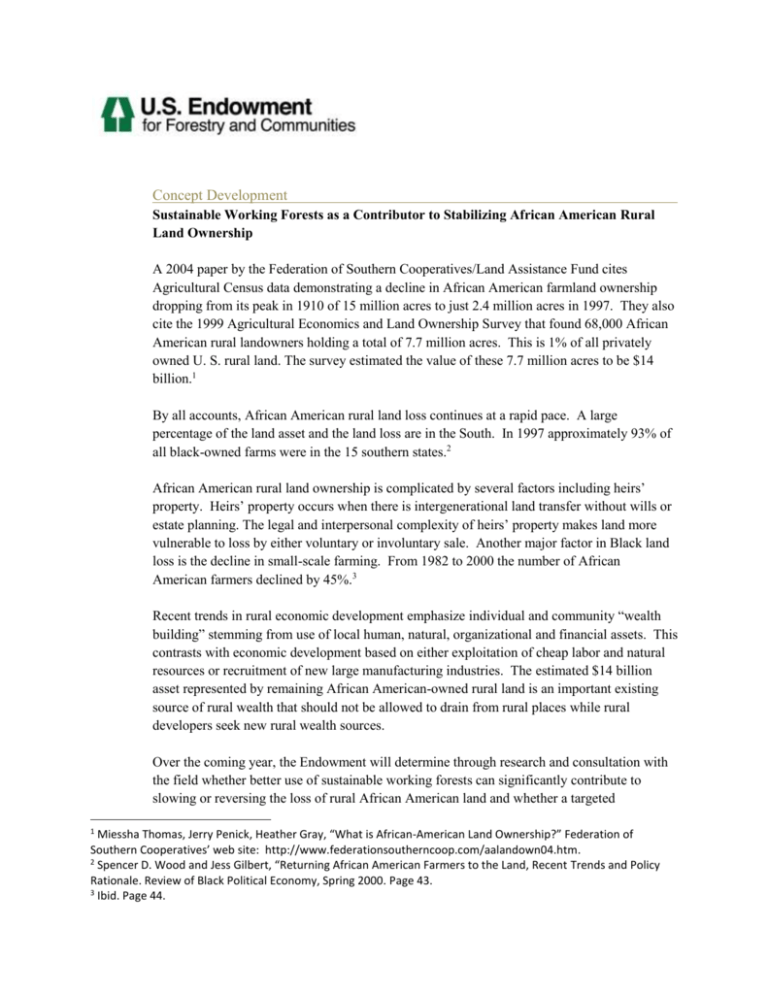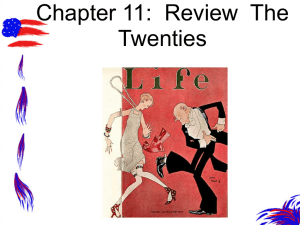Forestry and Land Retention Concept Statement
advertisement

Concept Development Sustainable Working Forests as a Contributor to Stabilizing African American Rural Land Ownership A 2004 paper by the Federation of Southern Cooperatives/Land Assistance Fund cites Agricultural Census data demonstrating a decline in African American farmland ownership dropping from its peak in 1910 of 15 million acres to just 2.4 million acres in 1997. They also cite the 1999 Agricultural Economics and Land Ownership Survey that found 68,000 African American rural landowners holding a total of 7.7 million acres. This is 1% of all privately owned U. S. rural land. The survey estimated the value of these 7.7 million acres to be $14 billion.1 By all accounts, African American rural land loss continues at a rapid pace. A large percentage of the land asset and the land loss are in the South. In 1997 approximately 93% of all black-owned farms were in the 15 southern states.2 African American rural land ownership is complicated by several factors including heirs’ property. Heirs’ property occurs when there is intergenerational land transfer without wills or estate planning. The legal and interpersonal complexity of heirs’ property makes land more vulnerable to loss by either voluntary or involuntary sale. Another major factor in Black land loss is the decline in small-scale farming. From 1982 to 2000 the number of African American farmers declined by 45%.3 Recent trends in rural economic development emphasize individual and community “wealth building” stemming from use of local human, natural, organizational and financial assets. This contrasts with economic development based on either exploitation of cheap labor and natural resources or recruitment of new large manufacturing industries. The estimated $14 billion asset represented by remaining African American-owned rural land is an important existing source of rural wealth that should not be allowed to drain from rural places while rural developers seek new rural wealth sources. Over the coming year, the Endowment will determine through research and consultation with the field whether better use of sustainable working forests can significantly contribute to slowing or reversing the loss of rural African American land and whether a targeted 1 Miessha Thomas, Jerry Penick, Heather Gray, “What is African-American Land Ownership?” Federation of Southern Cooperatives’ web site: http://www.federationsoutherncoop.com/aalandown04.htm. 2 Spencer D. Wood and Jess Gilbert, “Returning African American Farmers to the Land, Recent Trends and Policy Rationale. Review of Black Political Economy, Spring 2000. Page 43. 3 Ibid. Page 44. investment by the Endowment could catalyze better use of these forestlands and help stop land loss. There are several assumptions to be tested through this process: 1. A significant portion of rural African American-owned land is forested; 2. Much of African American-owned forestland, like much of forestland held in smaller land holdings, is not being managed sustainably or for maximum, long-term economic benefit and landowners are not fully benefitting from non-timber forest value streams; 3. Creating increased economic benefit from sustainably managed African Americanowned forestland will help reduce land loss in the short-term by providing income to help pay taxes and the legal and technical costs to clear heirs’ property titles, and, in the long-term, by providing ongoing income through multiple forest value steams; 4. An investment by the Endowment will leverage other investment of public, philanthropic, and private resources that in total are sufficient to create significant and measureable change in the problem of African American rural land loss. The Endowment will test these assumptions and decide about what actions, if any, it should take to help solve the problem by: 1. Research to understand the scope and causes of African American rural land loss and its relationship to forest management through reference to existing information and, if needed, contracting for new research. 2. Developing direct relationships with the organizations and people who are leading current efforts to reverse land loss and appropriate rural development and sustainable forestry practitioners. 3. Gathering these practitioners to advise and develop strategy. The Endowment staff will present its findings from this process and make any recommendations for action on them to the Endowment’s Board of Directors by it fall 2011 meeting.






